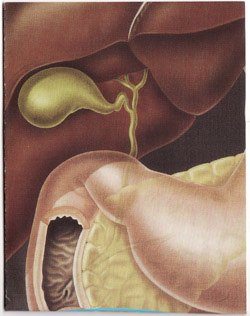ERCP
What is ERCP?

ERCP stands for Endoscopic Retrograde Cholangio - Pancreatography. It is an endoscope that consists of a thin, lighted fibreoptic tube with a camera attached to its tip. The camera relays images onto a monitor so that your doctor can clearly view the organs and detect any abnormality or disease. The scope also allows other instruments to be passed through it to perform biopsies, remove polyps or inject solution. A dye is injected into the bile and pancreatic ducts using a flexible, video endoscope. X-rays are then taken to outline the bile ducts and pancreas.
What are the functions of the liver and pancreas in digestion?
The liver produces bile, which flows through the ducts, passes or fills the gallbladder and then enters the intestine (duodenum) just beyond the stomach. The pancreas, which is six to eight inches long, sits behind the stomach. This organ secretes digestive enzymes that flow into the intestine through the same opening as the bile. Both bile and enzymes are needed to digest food.
Equipment
The video endoscope is a remarkable piece of equipment that can be directed and moved around the many bends of the upper gastrointestinal tract. A thin, glass fibreoptic bundle collects light at one tip of the scope and, regardless of how it is angled, transmits the image to the other viewing end. An open channel in the scope allows other instruments to be passed through it to perform biopsies, remove polyps or inject solution.
What are the indications of an ERCP?
ERCP helps in diagnosing and often in treating conditions of the bile ducts, gallbladder and pancreas such as:
- Gallstones trapped in the main bile duct
- Blockage of the bile duct
- Jaundice, which turns the skin yellow and the urine dark (due to an obstruction)
- Undiagnosed upper abdominal pain
- Cancer of the bile ducts or pancreas
- Pancreatitis (inflammation of the pancreas)
How do I prepare for ERCP?
The only preparation needed before an ERCP is to fast for 8 hours prior to the procedure. You should inform your doctor of all the medications you are taking so you can be advised on those you can take and the ones you should avoid.
How is an ERCP performed?
A local anaesthetic is sprayed in your throat and an intravenous anaesthetic/sedative will be given to make you more comfortable during the test. You may also receive antibiotics before the procedure.
The test begins with you lying on your left side on an X-ray table. The endoscope is passed through the mouth, oesophagus and stomach into the duodenum. Some air is introduced to inflate the digestive tract for better visibility. A contrast dye is then injected and X-ray taken to identify any abnormalities.
What can I expect after ERCP?
After ERCP, you will be monitored until your sedative wears off. You may have a sore throat for a few days, which will resolve on its own. You will be advised on your diet and will be able to take your medications.
What are the possible complications of ERCP?
ERCP is generally a well-tolerated procedure when performed by specialists who have had training and experience in this technique. However, as with all surgeries, it may be associated with certain complications such as
- Serious pancreatitis
- Infections
- Bowel perforation
- Bleeding
These risks must be balanced against the benefits of the procedure and the risks of alternative surgical treatment of the underlying condition.






